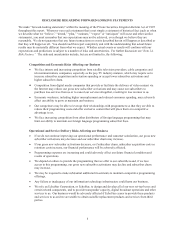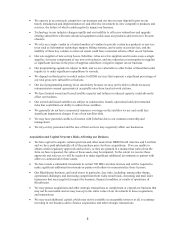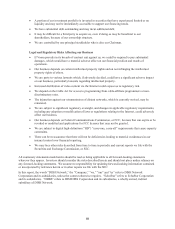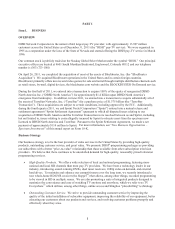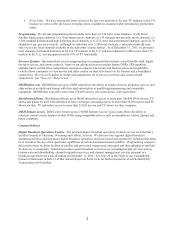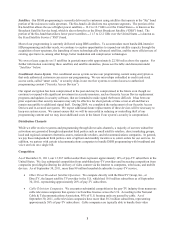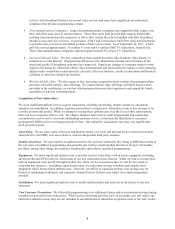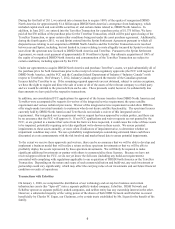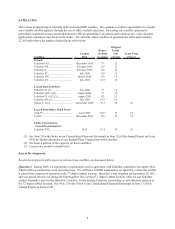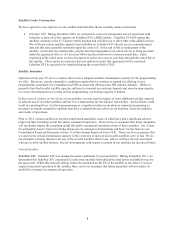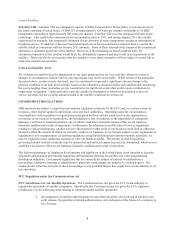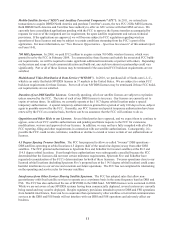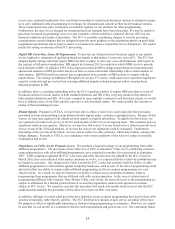Dish Network 2011 Annual Report Download - page 14
Download and view the complete annual report
Please find page 14 of the 2011 Dish Network annual report below. You can navigate through the pages in the report by either clicking on the pages listed below, or by using the keyword search tool below to find specific information within the annual report.4
4
services with broadband Internet access and voice services and many have significant investments in
companies that provide programming content.
x Telecommunications Companies. Large telecommunications companies have upgraded older copper wire
lines with fiber optic lines in certain markets. These fiber optic lines provide high capacity bandwidth,
enabling telecommunications companies to offer video content that can be bundled with their broadband
Internet access and voice services. In particular, AT&T and Verizon have built fiber-optic based networks
to provide video services in substantial portions of their service areas. As of September 30, 2011, AT&T
and Verizon had approximately 3.6 million U-verse and 4.0 million FiOS TV subscribers, respectively.
These telecommunications companies represent approximately 8% of pay-TV subscribers.
x Internet Delivered Video. We face competition from content providers who distribute video directly to
consumers over the Internet. Programming offered over the Internet has become more prevalent as the
speed and quality of broadband networks have improved. Significant changes in consumer behavior with
regard to the means by which they obtain video entertainment and information in response to this emerging
digital media competition could materially adversely affect our business, results of operations and financial
condition or otherwise disrupt our business.
x Wireless Mobile Video. We also expect to face increasing competition from wireless telecommunications
providers who offer mobile video offerings. We expect mobile video offerings will likely become more
prevalent in the marketplace as wireless telecommunications providers implement and expand the fourth
generation of wireless communications.
Acquisition of New Subscribers
We incur significant upfront costs to acquire subscribers, including advertising, retailer incentives, equipment
subsidies and installation. In addition, customer promotions to acquire new subscribers result in less revenue to us
over the promotional period. While we attempt to recoup these upfront costs over the lives of their subscriptions,
there can be no assurance that we will. We employ business rules such as credit requirements and contractual
commitments, and we strive to provide outstanding customer service, to increase the likelihood of customers
keeping their DISH service over longer periods of time. Our subscriber acquisition costs may vary significantly
from period to period.
Advertising. We use print, radio, television and Internet media, on a local and national basis to motivate potential
subscribers to call DISH, visit our website or contact independent third party retailers.
Retailer Incentives. We pay retailers an upfront incentive for each new subscriber they bring to DISH that results in
the activation of qualified programming and generally pay retailers small monthly incentives for up to 60 months;
provided, among other things, the customer continuously subscribes to qualified programming.
Equipment. We incur significant upfront costs to provide our new subscribers with in-home equipment, including
advanced HD and DVR receivers, which most of our new subscribers lease from us. While we seek to recoup these
upfront equipment costs mostly through monthly fees, there can be no assurance that we will be successful in
achieving that objective. In addition, upon deactivation of a subscriber we may refurbish and redeploy their
equipment which lowers future upfront costs. However, our ability to capitalize on these cost savings may be
limited as technological advances and consumer demand for new features may render the returned equipment
obsolete.
Installation. We incur significant upfront costs to install satellite dishes and receivers in the homes of our new
customers.
New Customer Promotions. We often offer programming at no additional charge and/or promotional pricing during
introductory periods for new subscribers. While such promotional activities have an economic cost and reduce our
subscriber-related revenue, they are not included in our definitions of subscriber acquisition costs or the SAC metric.






